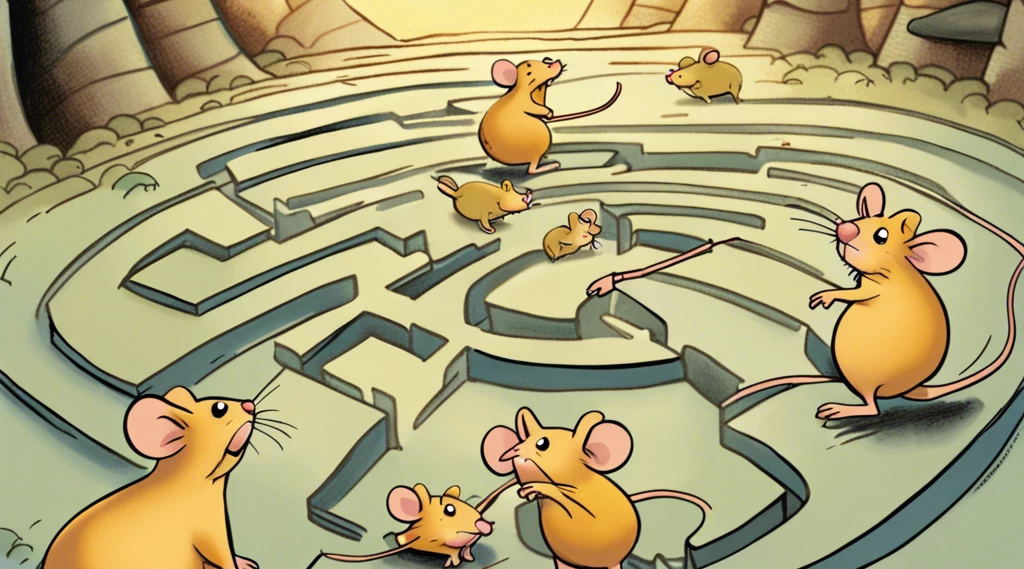– Switch & Who Moved My Cheese
Change is an inevitable part of life, and how we adapt to it can greatly influence our success and overall well-being. In the realm of personal development and organizational management, numerous books have been written to provide insights and strategies for navigating change effectively. This comparative study aims to explore two influential works in this genre: “Switch” by Chip Heath and Dan Heath, and “Who Moved My Cheese” by Dr. Spencer Johnson.
Both “Switch” and “Who Moved My Cheese” dive into the subject of embracing change and offer valuable perspectives on how individuals and organizations can thrive amidst shifting circumstances. While they share a common goal, these books approach the topic from different angles, utilizing distinct storytelling techniques and theoretical frameworks. By examining their similarities and differences, we can gain a deeper understanding of the strategies and principles they present.
In this study, we will delve into the key themes, methodologies, and practical advice offered by each book. We will also analyze the effectiveness of their approaches and their potential impact on readers. Ultimately, this comparative analysis seeks to provide readers with a comprehensive overview and critical assessment of both “Switch” and “Who Moved My Cheese.”
Through this exploration, we hope to uncover valuable insights that can be applied not only to personal lives but also to various professional contexts. Whether you are seeking guidance in adapting to change within your organization or looking to make personal transformations, this comparative study aims to equip you with the knowledge needed to embrace change proactively and achieve long-term success.
Summary of Two Books
Switch
“Switch: How to Change Things When Change is Hard” is a book written by Chip Heath and Dan Heath. It explores the concept of change and provides practical strategies for making lasting changes in personal life, organizations, and society. The authors use the metaphor of a rider (the rational mind), an elephant (the emotional mind), and a path (the surrounding environment) to explain how change occurs.
The book emphasizes that successful change requires addressing all three aspects—the rider, the elephant, and the path. It suggests that the rider needs clear direction and logical reasoning, while the elephant requires motivation and emotional appeal. Additionally, the path needs to be shaped to make change easier and more likely to happen.
Throughout the book, the authors provide engaging stories and case studies to illustrate their ideas. They share various techniques such as finding the bright spots (identifying what’s already working well), scripting critical moves (creating clear action plans), and rallying the herd (influencing others to support the change).
Overall, “Switch” offers valuable insights into understanding human behavior and provides practical guidance for navigating change successfully, whether on an individual or organizational level. It encourages readers to approach change with empathy, creativity, and a systematic approach to increase the chances of achieving positive and sustainable transformations.
Who Moved My Cheese
“Who Moved My Cheese?” is a bestselling self-help book written by Spencer Johnson. The book uses a fictional story to illustrate the importance of adapting to change and embracing it in our personal and professional lives.
The story revolves around four characters, two mice named Sniff and Scurry, and two little people, Hem and Haw, who live in a maze and depend on finding cheese for their happiness and success. The cheese symbolizes various things like job security, relationships, money, or any source of fulfillment in life.
At the beginning of the story, the characters discover a large supply of cheese in one location, which they rely on every day. However, one day, the cheese suddenly runs out. While Sniff and Scurry quickly accept the change and start searching for new cheese elsewhere in the maze, Hem and Haw resist and hold onto the hope that the cheese will return.
As the story progresses, Hem and Haw slowly realize that clinging to the old ways won’t bring back the cheese. Haw eventually decides to embrace change and sets out on a journey through the maze, leaving motivational writings called “A-Maze-ing” on the walls. He learns valuable lessons along the way, such as adapting to change, embracing uncertainty, and not fearing failure.
Ultimately, the book teaches readers the importance of being proactive in anticipating and embracing change rather than waiting for it to happen. Through simple yet profound insights, “Who Moved My Cheese?” encourages individuals to step out of their comfort zones and see change as an opportunity for growth and success.

Comparison Between Two Books
Similarities in Transformation
Switch and Who Moved My Cheese are both books that explore the theme of transformation, albeit from different angles. Let’s discuss some of the similarities between these two books in terms of their portrayal of transformation:
Embracing change:
Both books emphasize the importance of embracing change rather than resisting it. In Switch, the authors Chip Heath and Dan Heath argue that successful transformations occur when people direct the Rider (the rational side) and motivate the Elephant (the emotional side) towards a common goal. Similarly, in Who Moved My Cheese, Spencer Johnson illustrates that those who adapt to change quickly fare better than those who resist it.
Overcoming fear:
Another similarity between the books is the focus on overcoming fear during transformation. In Switch, the authors highlight how fear can paralyze individuals and hinder change. They suggest finding ways to minimize fear by providing clarity, building confidence, and creating a supportive environment. In a similar vein, Who Moved My Cheese portrays characters who initially fear change but learn to face their fears and adapt to new circumstances.
Mindset shift:
Both books emphasize the need for a mindset shift during periods of transformation. In Switch, the authors advocate for shifting one’s perspective and focusing on the positive aspects of change as a way to facilitate transformation. Likewise, Who Moved My Cheese stresses the importance of letting go of old beliefs and adapting to new realities.
Taking proactive steps:
The books encourage taking proactive steps towards transformation rather than waiting for change to happen. In Switch, the authors emphasize the significance of planning, setting clear goals, and using small victories to build momentum. Similarly, in Who Moved My Cheese, the characters who actively search for new opportunities and adapt to change are more successful than those who wait passively.
Continuous learning and adaptation:
Both books stress the importance of continuous learning and adaptation. In Switch, the authors highlight the need to experiment, learn from failures, and adjust strategies accordingly. Likewise, Who Moved My Cheese underscores the idea that change is constant, and individuals must continuously adapt to new circumstances.
In summary, both Switch and Who Moved My Cheese illustrate the importance of embracing change, overcoming fear, shifting mindset, taking proactive steps, and continuously learning and adapting during periods of transformation. These books provide valuable insights and practical advice for individuals and organizations navigating through transformative experiences.
Divergence in Transformation
Both “Switch” and “Who Moved My Cheese” are books focused on change and transformation, but they approach the topic from different angles and offer distinct perspectives. Here are some key divergences in their themes and ideas about transformation:
Nature of Transformation:
“Switch” by Chip Heath and Dan Heath primarily focuses on organizational change and how to drive successful transformations within complex systems. It provides a framework for understanding and implementing change effectively. On the other hand, “Who Moved My Cheese” by Spencer Johnson explores personal change, focusing on adapting to life’s unexpected shifts and embracing new opportunities.
Application Scope:
“Switch” offers a broader perspective on transformation, applicable to businesses, organizations, and even individuals looking to create change within themselves or their environments. It addresses a wide range of contexts, such as corporate culture, healthcare systems, and social movements. In contrast, “Who Moved My Cheese” primarily targets readers seeking personal development and resilience in response to change.

Analytical Approach vs. Parable:
“Switch” takes an analytical approach, blending research, case studies, and practical strategies to provide insights into the psychology behind change. It offers a step-by-step framework for understanding and implementing change successfully. In contrast, “Who Moved My Cheese” employs a parable format featuring fictional characters to convey its message. It uses metaphors like the maze, cheese, and mice to illustrate core concepts and engage readers with relatable storytelling.
Focus on Behavior Change:
“Switch” emphasizes the significance of behavior change in driving successful transformations. It explores the roles of rational thinking, emotional motivation, and external influences in shaping behavior. The book delves into the concept of “rider” (analytical mind) and “elephant” (emotional mind), providing strategies to align them towards change. Conversely, “Who Moved My Cheese” highlights the importance of adapting to change by letting go of old beliefs and embracing new possibilities. It encourages readers to be proactive in seeking new opportunities rather than waiting for them.
Audience Perspective:
“Switch” is more targeted towards leaders, managers, and change agents who seek strategies to facilitate organizational or personal transformations. It offers insights into overcoming resistance to change and sustaining momentum throughout the process. Who Moved My Cheese,” on the other hand, appeals to a broader audience seeking inspiration and guidance in navigating life’s changes with resilience and adaptability.
In summary, while both books explore transformation and change, “Switch” provides a systematic framework for implementing change in various contexts, focusing on behavior change within organizations and individuals. “Who Moved My Cheese” presents a relatable parable about personal development and embracing change in life, encouraging readers to proactively seek new opportunities.
Conclusion
Both books, “Switch” and “Who Moved My Cheese,” offer valuable insights but address different aspects of personal and organizational change. Depending on your specific interests and needs, one may be more worthy of reading than the other.
“Switch” by Chip Heath and Dan Heath:
This book explores the psychology behind successful change and provides practical strategies for implementing it.
It delves into the rational and emotional processes that influence decision-making and behavior change.
“Switch” offers a comprehensive framework for navigating change, including directing the rational mind, motivating the emotional mind, and shaping the path to facilitate change.
“Who Moved My Cheese” by Spencer Johnson:
A parable about adapting to change, this book uses a simple story to illustrate the importance of embracing uncertainty and finding new approaches.
It emphasizes the need to let go of old habits and beliefs, and to proactively seek out new opportunities.
“Who Moved My Cheese” encourages readers to adopt a positive attitude towards change and view it as an opportunity for growth.
To determine which book is more worthy of reading, consider your specific context and objectives. If you’re interested in understanding the psychological dynamics of change and learning practical strategies to drive change efforts, “Switch” would be more suitable. On the other hand, if you prefer a concise parable that inspires you to embrace change with a positive mindset, “Who Moved My Cheese” might be the better choice.



